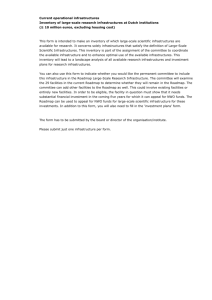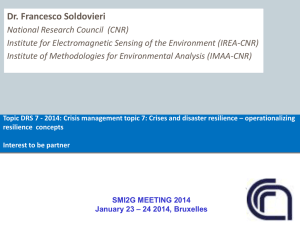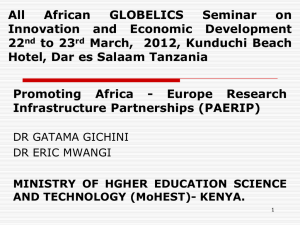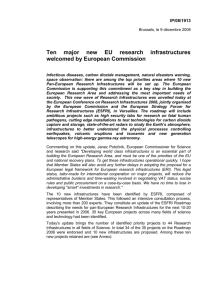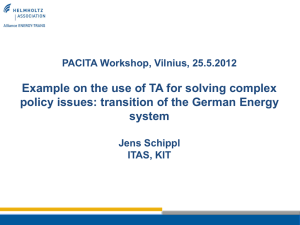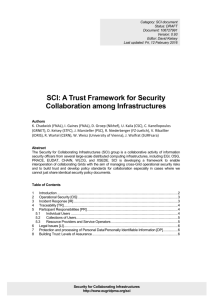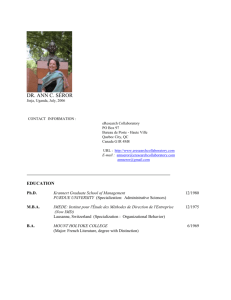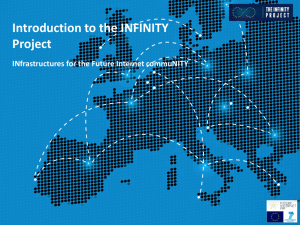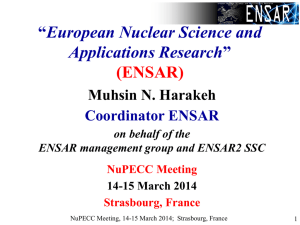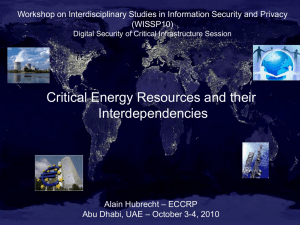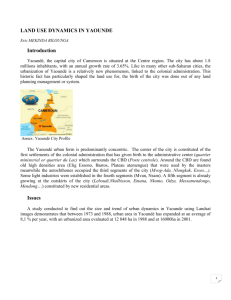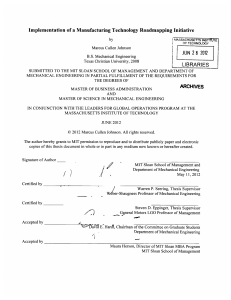OECD Stefan Michalowski
advertisement
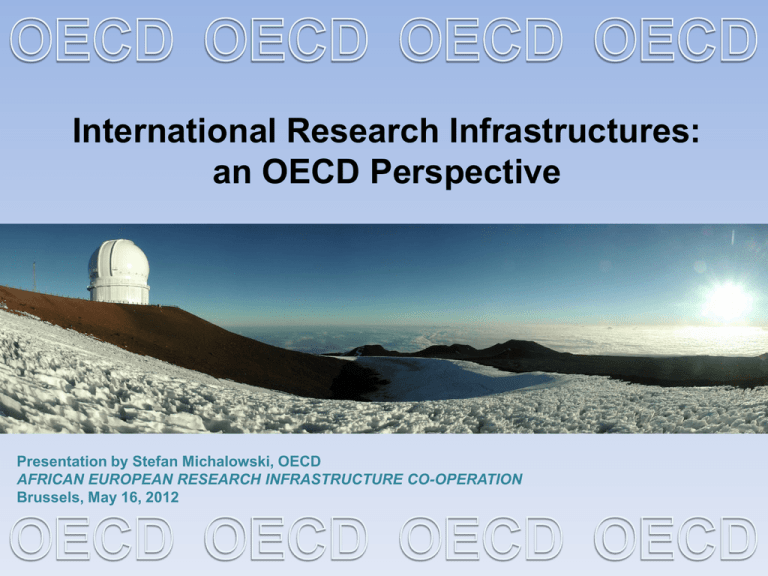
International Research Infrastructures: an OECD Perspective Presentation by Stefan Michalowski, OECD AFRICAN EUROPEAN RESEARCH INFRASTRUCTURE CO-OPERATION Brussels, May 16, 2012 Two topics: • What are research infrastructures, and why are they important from a science policy perspective? • What are the principal issues and options for planning, establishing and operating international research infrastructures? What is an Infrastructure? It can serve many users and many uses. It’s designed with the future in mind. Research Infrastructures: a pragmatic OECD taxonomy Facilities “Single Experiments” CERN LHC, ITER, JET, PIERRE AUGER User facilities for a small number of users User facilities for a large number of users ALMA, SKA, Big telescopes ESRF, ILL, XFEL, FAIR, ESS, LSST Distributed Infrastructures Scientific measurement using multiple facilities “… association or network of geographicallyEVN, LIGO/VIRGO distinct entities from more oseparated, Subdividing a large task among distinct institutions AGRP,than ICGC one that agree to jointly or sponsor country Coordination/integration of research based onperform a common scientific theme research.” obasic Coordination of a set of large infrastructures ELI, GEOSS, ELIXIR o Combining signals from a set of independent instruments o Coordination/integration of diverse projects/programmes SIOS, GEM o Provision of resources/services CLARIN, EMMA e-Infrastructures Federation, storage, curation of large data sets GBIF. INCF, CESSDA, Lifewatch High performance computing and networking GÉANT, PRACE Planning (Roadmapping) Creation Internationalisation Establishing Operating costs Operation Access to resources and to data Decommissioning Scientific impact Assessment Economic impact Societal impact Planning (Roadmapping) Creation Internationalisation Establishing Operating costs Operation Access to resources and to data Decommissioning Scientific impact Assessment Economic impact Societal impact Infrastructure Roadmaps Interesting properties of roadmaps and of roadmapping: May include non-scientific considerations • economic, regional development Can mobilise an entire scientific community • industrial innovation Promotes innovation a competitive environment • education and inworkforce issues Encourages multi- and inter-disciplinarity • international political integration • national security Illuminates important science policy issues: The role of existing infrastructures Balancing supply and demand of research resources Understanding the size of the overall effort Comparing infrastructure costs Access rules and policies Workforce issues Caveats: Not the best tool for deciding about existing ISs Large, expensive ISs can stress science budgets Potential neglect of small and medium projects Inflexibility of long-tem commitments Overly broad scope could lead to loss of focus National/Regional/Global interference Confusion from proliferation of diverse RMs THE ISSUES - Legal and Administrative - Funding and Contributions - Project Management - Equipment - Personnel The downsides of internationalisation are not ignored Inhibition of competition in fields where it has traditionally been vigorous and productive. Delays associated with international negotiations. Bringing non-scientific actors (lawyers, diplomats, etc.) into the process. Exclusion/isolation of certain national scientific communities. Sub-optimal technical solutions due to juste retour. Creation of new/untried institutions/structures: administrative/bureaucratic/legal/political. LEGAL AND ADMINISTRATIVE ISSUES International Organisation [archetype models: of ITER, CERN] • A basic taxonomy possible legal/administrative structures, and their chief (LLC) characteristics. Nature of law Limited Liability Company under national documents for eachtotype structure foundation Allocating the right tasks negotiators [archetype models: ESRF, XFEL]theofright (including typical time period for negotiation) Scope and organisationnational of the negotiations Association of independent or regional • Creating a new organisation vs. using an existing Bi-lateral or[archetype multi-lateral? infrastructures model: ALMA] one The role collaborating of “Science Cases” Ex-post-facto infrastructures • The elements of an administrative structure and [archetype models:issue LIGO/VIRGO/GEO] their Theinter-relationships language Foundation under national law [archetype model: JIVE] • International negotiations European Infrastructure • AccessResearch issues (to the infrastructure Consortium itself, and to (ERIC) experimental A digression: thedata) HEP detector model • Intellectual property • Site and host selection FUNDING AND CONTRIBUTIONS • Host premium and host benefits. • Cash vs. In-Kind: deciding the best proportion of each, the pros and cons. • In-Kind: methods for assigning value, dividing up assignments among Partners. • Juste retour: theory and practices. • Operating costs and scientific access • Risk Analysis. Contingencies and cost overruns. Quality control. Openness and accountability. • Contracting by the Organisation (esp. in Partner countries). PROJECT MANAGEMENT • Relationship to Risk Analysis, and to generic issues of accountability, authority and communication between the chief actors (the Organisation and the Partners). • Examples of scope of PM (e.g., purchasing, contracting, hiring). Use of commercial software and of external contractors. Role of experienced individuals. • Data availability and quality issues, especially access to information held by Partners. • Possibility of adopting agreed international standards. • Special vulnerability issues in the start-up phases. • Special challenges to international scientific communities, especially when transitioning to large infrastructures. PERSONNEL • Recruitment and contracts • Organisation hires vs. secondees. • Staff regulations (incl. issues of authority). • Conflict of interest. • Family issues. EQUIPMENT • Responsibility for testing, acceptance and transfer of ownership. • Liability in case of malfunction. • Disposition at decommissioning. • IPR Major Issues (personal view) • Is internationalisation the best solution? • Plan the negotiations: phases and people. Agree on language(s). Expect significant delays • Agree on site selection procedure • Use an existing legal/administrative entity? • Weigh the pros and cons of cash vs. in-kind, and adapt the governance • Address operating costs and links to access • Choose a project management methodology • Anticipate decommissioning Planning (Roadmapping) Creation Internationalisation Establishing Operating costs Operation Access to resources and to data Decommissioning Scientific impact Assessment Economic impact Societal impact TAXONOMY OF IMPACTS I. Purely scientific results, intended to advance fundamental knowledge. II . The direct impact of spending for constructing and operating the laboratory. III. Training scientists, engineers, technicians, administrators and others. IV. Developing and perfecting modalities of international scientific cooperation. V. Bringing nations together, strengthening capacity in developing countries. VI. Non-HEP innovations that emerge during the main scientific mission. VIa. Innovations needed for major component development / procurement. VIb. Innovations that can become impacts with only minor modifications. VIc. Innovations that can become impacts with major additional efforts. VII. Education, and public outreach. GENERIC (COMMON) ISSUES Relationship to the primary mission of the lab. Involvement/role of the member countries and funding agencies. Role and responsibility of senior laboratory managers. How non-HEP impact-generating projects begin. Staff issues. Finances. Intellectual property. Interactions with industry. The innovation cycle (from idea to product). Structure and functioning of a knowledge transfer office. Thank you



